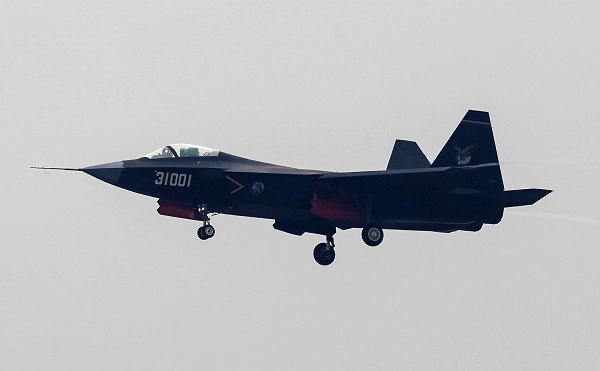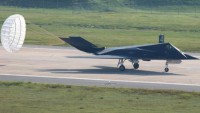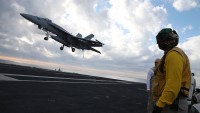China Closing Technology Gap With US, Says US Air Force Official
| Carlos Castillo | | Feb 18, 2016 07:59 AM EST |
(Photo : Reuters) A J-31 stealth fighter, which looks a lot like the U.S. F-35 it copied.
The technology gap between US and Chinese jet fighters is being narrowed, although the training and experience of US pilots still allows them an "unbelievably huge" advantage over their Chinese counterparts, a top US air force official has said.
Speaking to Bloomberg News on the sidelines of an air show in Singapore, the commander of the US Pacific Air Forces General Lori Robinson said on Tuesday that China is closing the technology divide between US and Chinese warplanes.
Like Us on Facebook
"The technology gap certainly is closing, there's no denying that," Robinson said, adding, however, that the overall experience, training and support received by American fighter pilots affords the US a significant edge over China in terms of air superiority. "That edge is unbelievably huge."
No Budget Constraints
China's People's Liberation Army (PLA) has enjoyed two decades of double-digit budget increases. This has allowed the Chinese military to invest billions into longer-range and higher-tech warplanes, ships and submarines, according to analysts at the RAND Corporation.
China has by now replaced half its fighter fleet with fourth generation jet fighters, says RAND. And the country continues to make advances in research and development.
The US is reportedly working on its next generation of bombers, which is likely to have a fighter component. Already, however, there is some debate within the Pentagon about its tremendous development cost, according to the Washington Post.
Unfettered by budget constraints, China is meanwhile said to be working on no less than four airframe designs for its fifth generation stealth fighter.
In November, scientists from China's Huazhong University of Science and Technology announced that they had created lightweight stealth material with absorbers that could make planes and ships more difficult to detect using current anti-stealth radar.
"Our proposed absorber is almost 10 times thinner than conventional ones," said Wenhua Xu, one of the scientists.
It is not clear whether the Chinese government will be using the material on its two stealth jets already in production, the Chengdu J-20 and the Shenyang J-31. But experts say the new material would give the Chinese military a dramatic increase in capability both in the air and in the sea.
"Rules of Behavior"
Security analysts, however, have raised concerns that Chinese pilots would behave rashly in proximity to planes from other nations. Much of their training time is spent learning doctrine, critics say, not actual flying.
Bloomberg meanwhile notes the likelihood of interaction between US and Chinese pilots have increased dramatically as a result of China's aggressive claims to over 80 percent of the South China Sea.
Two years ago, a Chinese jet fighter flew within 20 feet of a US P8 Poseidon flying at speeds approaching 400 miles per hour near Hainan Island, over the South China Sea.
Robinson said US military pilots on missions over the South China Sea have at times received radio warnings from the Chinese military, telling them to leave. She said Japanese pilots have had similar experiences when flying over the East China Sea.
The air force general nonetheless finds reassurance in the professionalism of Chinese pilots, citing a September agreement between China and the US on rules of behavior during such air encounters.
"They are talking, but mostly in my world from airplanes to airplanes everybody has acted professionally in accordance with the rules of behavior," said Robinson.
Claiming the US air force will continue to fly in international airspace when required, Robinson said any talk that a rising China will soon compel the US to cede hard-won ground in the Asia-Pacific region is hypothetical.
"What I depend upon today is our presence in the region, because our presence in the region provides that stability and capability in the region," Robinson asserted. "Our presence in the region allows for us to have partnerships throughout the region."
TagsUS-China relations, Military Technology, Territorial disputes in the South China Sea
©2015 Chinatopix All rights reserved. Do not reproduce without permission
EDITOR'S PICKS
-

Did the Trump administration just announce plans for a trade war with ‘hostile’ China and Russia?
-

US Senate passes Taiwan travel bill slammed by China
-

As Yan Sihong’s family grieves, here are other Chinese students who went missing abroad. Some have never been found
-

Beijing blasts Western critics who ‘smear China’ with the term sharp power
-

China Envoy Seeks to Defuse Tensions With U.S. as a Trade War Brews
-

Singapore's Deputy PM Provides Bitcoin Vote of Confidence Amid China's Blanket Bans
-

China warns investors over risks in overseas virtual currency trading
-

Chinese government most trustworthy: survey
-

Kashima Antlers On Course For Back-To-Back Titles
MOST POPULAR
LATEST NEWS
Zhou Yongkang: China's Former Security Chief Sentenced to Life in Prison

China's former Chief of the Ministry of Public Security, Zhou Yongkang, has been given a life sentence after he was found guilty of abusing his office, bribery and deliberately ... Full Article
TRENDING STORY

China Pork Prices Expected to Stabilize As The Supplies Recover

Elephone P9000 Smartphone is now on Sale on Amazon India

There's a Big Chance Cliffhangers Won't Still Be Resolved When Grey's Anatomy Season 13 Returns

Supreme Court Ruled on Samsung vs Apple Dispute for Patent Infringement

Microsoft Surface Pro 5 Rumors and Release Date: What is the Latest?












